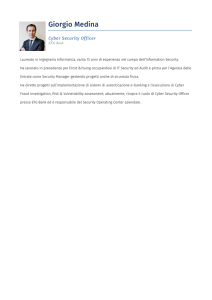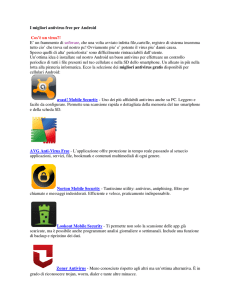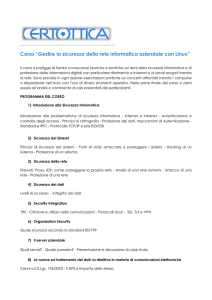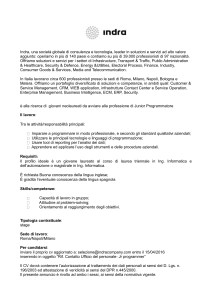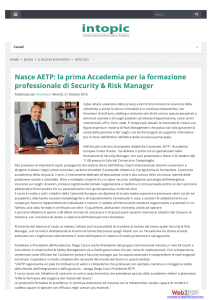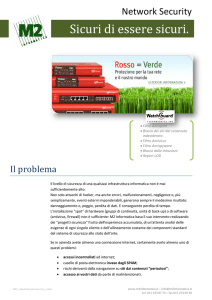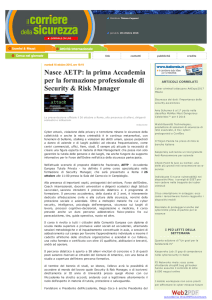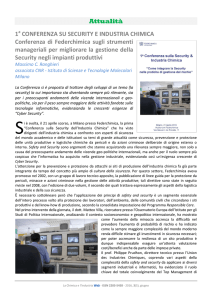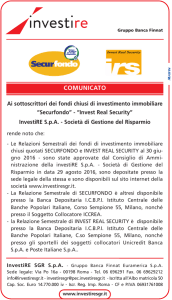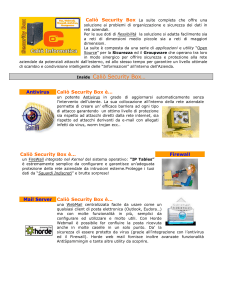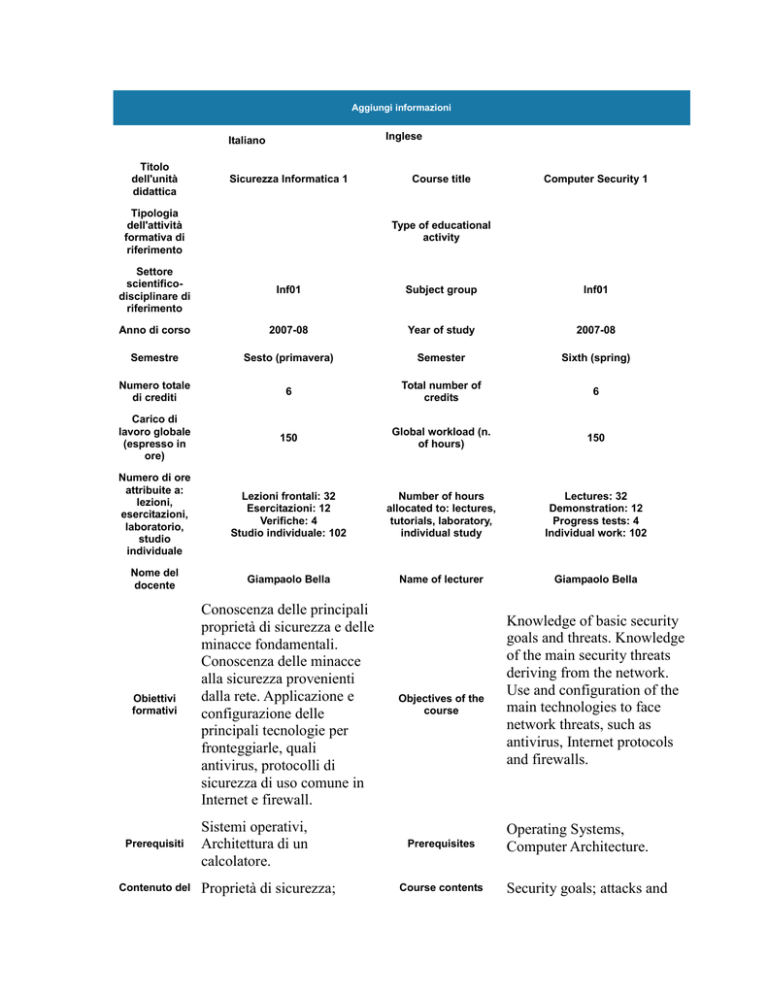
Aggiungi informazioni
Inglese
Italiano
Titolo
dell'unità
didattica
Sicurezza Informatica 1
Tipologia
dell'attività
formativa di
riferimento
Course title
Computer Security 1
Type of educational
activity
Settore
scientificodisciplinare di
riferimento
Inf01
Subject group
Inf01
Anno di corso
2007-08
Year of study
2007-08
Semestre
Sesto (primavera)
Semester
Sixth (spring)
Numero totale
di crediti
6
Total number of
credits
6
Carico di
lavoro globale
(espresso in
ore)
150
Global workload (n.
of hours)
150
Numero di ore
attribuite a:
lezioni,
esercitazioni,
laboratorio,
studio
individuale
Lezioni frontali: 32
Esercitazioni: 12
Verifiche: 4
Studio individuale: 102
Number of hours
allocated to: lectures,
tutorials, laboratory,
individual study
Lectures: 32
Demonstration: 12
Progress tests: 4
Individual work: 102
Nome del
docente
Giampaolo Bella
Name of lecturer
Giampaolo Bella
Obiettivi
formativi
Conoscenza delle principali
proprietà di sicurezza e delle
minacce fondamentali.
Conoscenza delle minacce
alla sicurezza provenienti
dalla rete. Applicazione e
configurazione delle
principali tecnologie per
fronteggiarle, quali
antivirus, protocolli di
sicurezza di uso comune in
Internet e firewall.
Prerequisiti
Contenuto del
Sistemi operativi,
Architettura di un
calcolatore.
Proprietà di sicurezza;
Objectives of the
course
Prerequisites
Course contents
Knowledge of basic security
goals and threats. Knowledge
of the main security threats
deriving from the network.
Use and configuration of the
main technologies to face
network threats, such as
antivirus, Internet protocols
and firewalls.
Operating Systems,
Computer Architecture.
Security goals; attacks and
corso
Testi di
riferimento
Metodi
didattici
attacchi e attaccanti;
politiche di sicurezza
discrezionali o mandatorie
(Bell-LaPadula e Biba);
crittografia per la sicurezza,
protocolli di sicurezza,
attacchi ai protocolli,
protocollo Kerberos;
autenticazione su
conoscenza, possesso o
caratteristiche; vulnerabilità
del software, buffer
overflow, stack o heap
corruption. Software nocivo
(virus, worm, trapdoor,
cavalli di troia); antivirus,
sistemi immuni; sicurezza in
rete (IP spoofing, negazione
del servizio); rilevamento e
gestione delle intrusioni;
protocolli IPSec, SSH, SSL;
progettazione di un firewall,
configurazione di IpTables.
Steve Schneier: “Sicurezza
digitale”.
William Stallings: “Network
security essentials”.
Lezioni teoriche frontali,
esercitazioni in aula, prove
in itinere, esercitazioni
libere in laboratorio.
attackers; discretionary and
mandatory security policies
(Bell-LaPadula e Biba);
cryptography for security,
security protocols, protocol
attacks, Kerberos protocol;
authentication based upon
knowledge, ownership or
biometric features; software
vulnerability, buffer
overflow, stack or heap
corruption. Malicious
software (virus, worm,
trapdoor, trojan horses);
antivirus, immune systems;
network security (IP
spoofing, denial of service);
intrusion detection and
management; IPSec, SSH
and SSL protocols; firewall
technology, configuring
IpTables.
Recommended
reading
Teaching methods
Steve Schneier: “Secrets and
lies: digital security in a
networked world”.
William Stallings: “Network
security essentials”.
Lectures, group exercises,
laboratory free activity.
Tipo di esame
Prova teorica autenticata ma
anonima
Assessment methods
Authenticated though anonymous
theory exam
Lingua di
insegnamento
Italiano
Language of
instruction
Italian
Additional
information
Exams/interaction with lecturer
possible in English
Altre
informazioni

